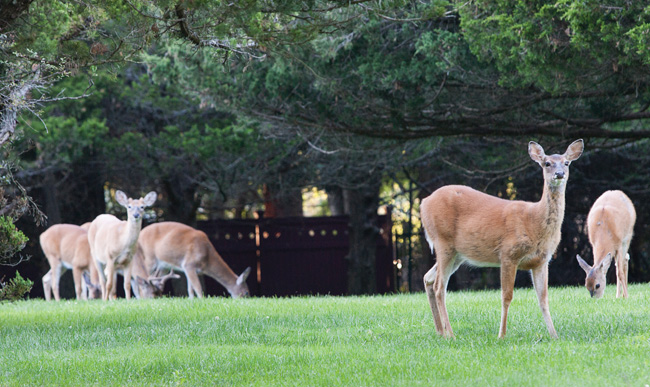Guest Spot: How deer have decimated our woodlands

Our woodlands are under attack. It’s not the first time. By 1750, loggers had removed nearly all trees and brush from Wading River to Southold. Action was taken. Laws were enacted. As a result, our woodlands came back. But unless steps are taken, and soon, the North Fork may once again experience a near total loss of our woodlands, which in turn will endanger not only wildlife but the protection of our land and our waters.
Whether a longtime resident or visitor, you’ve seen the difference. Over the past 10 years, studies in the Pine Barrens, at Mashomack Preserve on Shelter Island and at various Southold properties have documented the nearly complete loss of our understory – young trees, bushes, shrubs and ground cover – destroyed by an out-of-control deer population. Worse yet, these areas have shown no evidence of regrowth. None.
The number of deer in a given area depends on the availability of food and winter cover. If food sources dwindle, herd size would decrease through disease, starvation and lower birth rates. The trouble is that man has thrown the natural system out of balance. Landscaping and agricultural operations have provided abundant food supplies. As a result, deer are reproducing without limit. Because of the low mortality rate for adult deer and favorable conditions for reproduction, suburban deer herds can double in size every two to five years.
Our land consists of soil, water, plants and animals all working as part of an integrated ecosystem, one element dependent on the other. The true barometer of health is the ability of these ecosystems to flourish, self-renew and continue in balance. Our woodland ecosystems have lost that balance and ability to self-renew.
Deer have a large and varied diet. There’s little they won’t eat at one time or another. Twigs, leaves, bark, grasses, weeds and soft-stemmed plants, acorns, other nuts, fruits, mushrooms, algae and mosses are all on their menu. But at their base, deer thrive on the seedlings of most species and, over a short period of time, strip the understory bare. In its current state, it could take decades or even hundreds of years to restore our woodlands.
The loss of the understory, of new trees and of tree and plant diversity, has altered food sources, mating, nesting and nursery sites for insects, birds and small mammals. In addition, as older trees are lost to disease and storm damage, with no new trees coming to replace them, birds like the woodpecker, chickadee and tree swallow have no place to nest. And with no ground cover, towhee and bobwhite numbers have plummeted. The Pine Barrens alone are home to many rare and threatened plant and animal species. Are we to do nothing and just let them disappear?
Healthy woodlands also play important roles in our well being. Trees and plants take carbon dioxide from the air and sequester or store the carbon in the plant while releasing oxygen. Their root systems not only hold soils in place, preventing erosion and loss of fertile soils into our surrounding waterways, they also absorb nitrogen from natural sources like animal waste, from the atmosphere – up to 20 percent of the nitrogen going into our groundwater and surface waters comes from air, rain and snow — and from man-made sources like fertilizers. Without healthy woodlands to take up this nitrogen, our efforts to protect our drinking water and the health of our inlets and bays is in even greater peril.
As deer remove all native plants, they’re not only helping invasive plant species to grow in these newly opened areas and allowing them to take over the ecosystem, they’re actually spreading them to new areas. Deer consume the seeds and fruits of many plant species and, when excreted, a large number remain viable. In a Connecticut study, seedlings of 57 different plant species were germinated from deer pellets. Of these, 32 species were exotic non-natives, many of which are highly invasive species, such as autumn olive. So limiting deer populations would help prevent, or at least reduce, the spread of undesirable plant species and help maintain viable native plant populations.
Suffolk County and the five East End towns have invested a good deal of money, our money, toward land preservation. While the underlying purpose is to protect our drinking water supplies, a secondary purpose is to preserve our natural environment for the enjoyment of all. But if we let deer continue to destroy our woodlands and hinder our efforts to protect drinking water supplies, are we really doing right by us and the environment?
We risk losing more than a few plants or trees. We risk losing what makes the North Fork a destination for homeowners and tourists alike. We risk losing our battle to protect our drinking water supplies. And we risk losing the number of plant, bird and animal species that make our natural ecosystems work and productive. It doesn’t matter what values you hold dear and what you want to preserve or enhance — whether it be deer hunting, animal rights, recreation, drinking water protection or the integrity of our ecosystems — deer are having a dramatic, negative effect on all the values we all hold dear. We and our environment are suffering. Actions need to be taken.
As much of the land in Southold Town is privately owned, deer management by private landowners is extremely important in reducing the local deer population. If you have a parcel that routinely hosts a number of deer and you are interested in having a hunter hunt your property, please call Southold Town at 631-765-1283 and they can assist you with contact information.
 The author is the executive director of the North Fork Environmental Council. This column is the first in a series of six guest spots being submitted by the North Fork Deer Management Alliance. They will be published on the fourth Thursday of each of the next six months.
The author is the executive director of the North Fork Environmental Council. This column is the first in a series of six guest spots being submitted by the North Fork Deer Management Alliance. They will be published on the fourth Thursday of each of the next six months.








